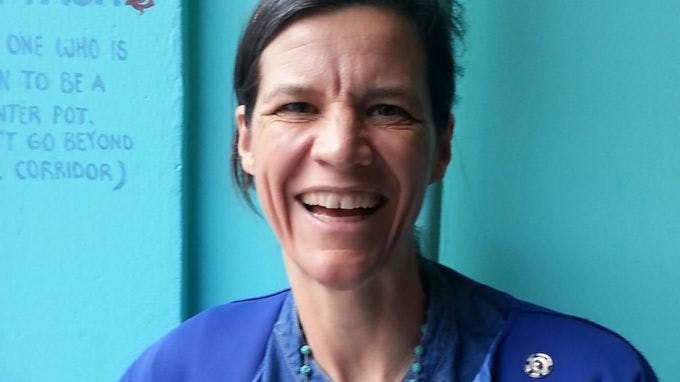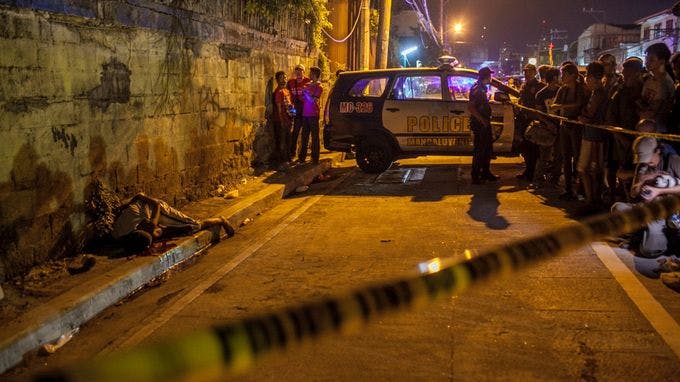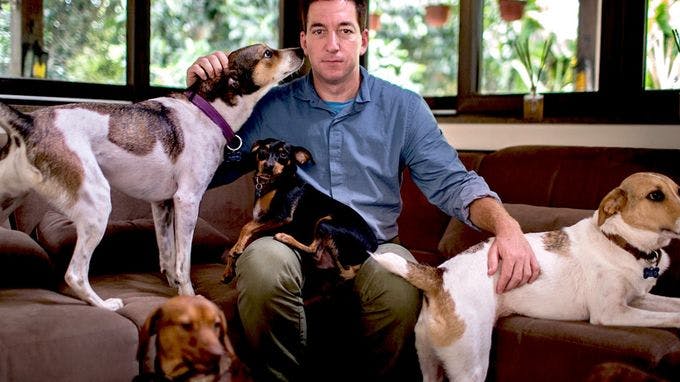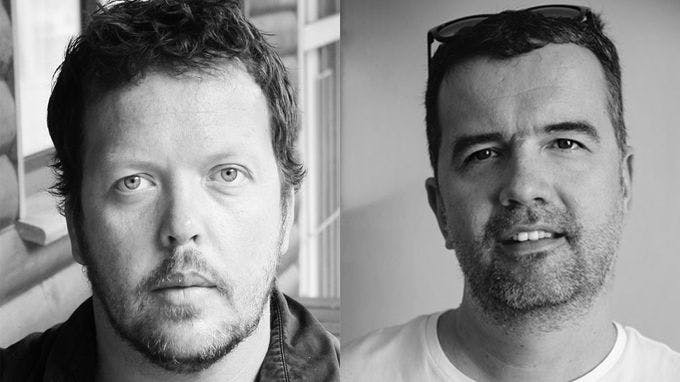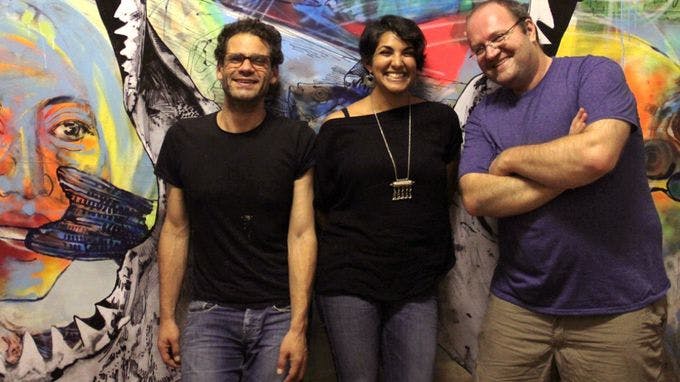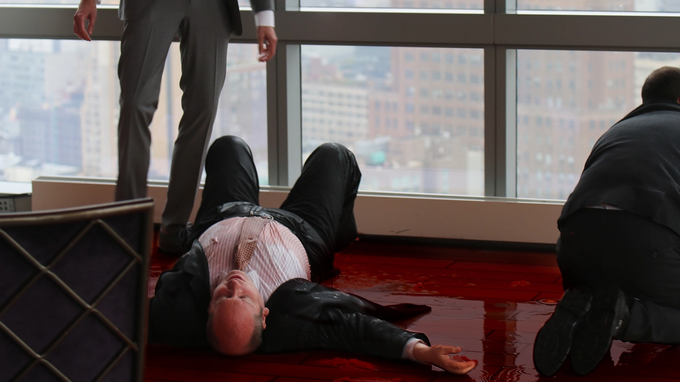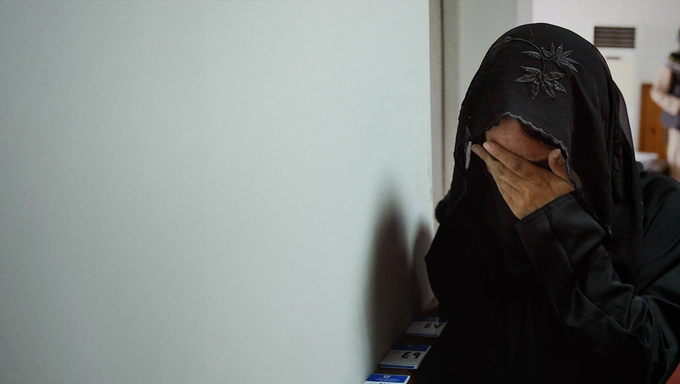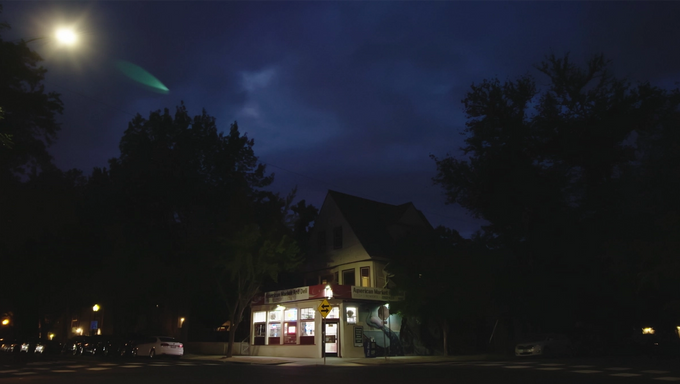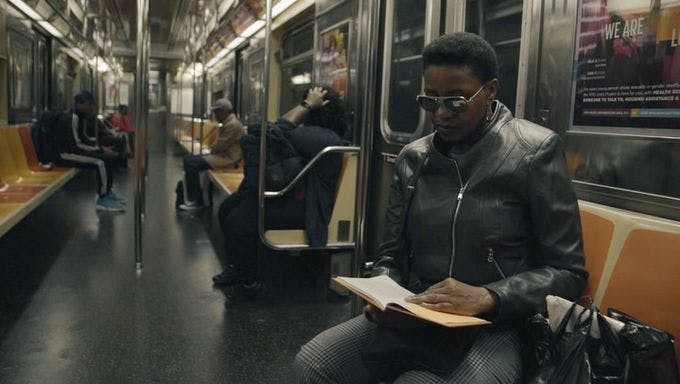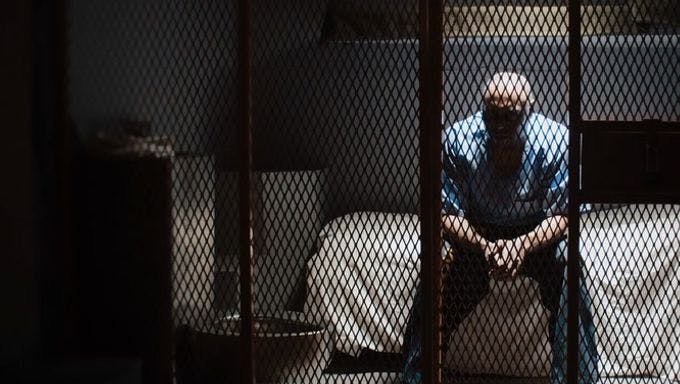After two years of preparation, the visual journalism wing of The Intercept goes public this month, led by an episodic series directed by Intercept co-founder Laura Poitras (Academy Award-winning director of Citizenfour) that offers a dramatic firsthand chronicle of the events that led Julian Assange to seek asylum in London, set to premiere at the New York Film Festival on September 27. During this calm before the storm, Poitras was joined by her two collaborators — fellow filmmaker AJ Schnack (Caucus, We Always Lie to Strangers, co-founder of the Cinema Eye Honors) and Charlotte Cook, until recently the director of programming for Hot Docs Film Festival in Toronto — to talk about their vision for Field of Vision, the glories of working in shorter forms, and the richly fertile ground between cinema and journalism.
Where did the idea for Field of Vision come from, and what was the motivation behind it?
Laura Poitras: In 2013, when I was reporting on the Snowden material, Glenn Greenwald, Jeremy Scahill and I decided to work together. What I wanted to do is use visual journalism in a different kind of way. I proposed a structure where we had a really small team that would commission work that would expand the language of visual journalism. I was in the process of editing Citizenfour, and when I finished that I reached out to Charlotte and AJ to see if they wanted to build this unit with me. I’ve known them both for many years, and in terms of their skills and knowledge of the documentary community, both have such vast experience. Field of Vision is very much a collaboration.
Why open this up to a wider community of filmmakers instead of taking the standard TV news tack of working with a fixed crew?
AJ Schnack: It seemed like a great time to engage the community in a way that was different from the ways that they tend to be engaged. For a lot of people, the notion of doing something in the short form and also quickly responding to something that’s happening in the world is something that, as both an exercise and as a way to create a piece of art, is somewhat new. Not just have a team of five filmmakers who will constantly churn stuff out, but instead to say — here’s an event happening right now in the Pacific Northwest, and there’s a filmmaker who would be perfect for it. Let’s call them and get them in the field next week. That was something that was really interesting to us, as a way of getting a bunch of different perspectives, as well as different people’s styles of nonfiction.
Poitras: We’re trying to be creatively exploratory. We’re very much approaching this as filmmakers and creative people. We are interested in intersections between visual storytelling and newsgathering, and how writing and video journalism can work together. When we think of things that inspire us, it’s like Life magazine, which was such a great platform for photography and print, or World In Action, a British series that was responding to events as they were unfolding in very cinematic ways.
Charlotte Cook: Traditionally, art hasn’t been seen as having a place within journalistic filmmaking. But Laura and AJ’s work shows this isn’t the case — that it can have a place. We’re really excited about pairing very artistic filmmaking with journalism.
Schnack: We also like the challenge aspect of it. Laura and I worked together, along with a bunch of other filmmakers, on a film called Convention, and it was in many ways an exercise. It was like, here’s your camera, here’s your assignment — go.
Poitras: With Convention, AJ invited filmmakers that he trusted to work in a verité style to film the 2008 Democratic Convention. We had less than a week on the ground — we didn’t have time to prep. We’d all go out and shoot and then at the end of the day we’d debrief. It’s an experience that’s scary, but it’s also creatively exciting — not doing just what you know, what’s safe or predictable. It’s also great because oftentimes working in long form is really tough. It’s like a marathon. We don’t get to use our chops as much as we want to. So to be on the ground, trying to do things with a quicker turnaround, we can respond to the world around us more quickly, and also the life cycle of the creative process is accelerated.
Cook: The beauty of this form is that it allows filmmakers to play with the craft. They’re not putting three years into a feature, they’re doing a short film, and they can think about perhaps different ways that they’ve never told stories before. We’re keen on looking at things from a different perspective, whether it’s a story that people are familiar with, or something that perhaps hasn’t been covered properly. And then being able to work with different kinds of artists, photojournalists, and data-literate journalists, to really see how people think visually about topical stories.
Poitras: We’re also excited about working with other journalists at The Intercept. For instance, Jeremy and Glenn do incredible reporting, let’s assign filmmakers to work with them.
We’re interested in visually driven storytelling. It doesn’t need to be verité. It could be data visualization. How do you communicate about the world through the tools that are available to us, as people who work in a visual medium? How can we understand the world differently through images? We’re going to have different interests among us, and I’m interested in a journalism component, a news component, in being responsive. I definitely have a leaning towards that, as opposed to something that’s just purely poetic and visual. I want that news edge, that journalism edge. But I don’t want it to be all that either.
Do you see it as potentially a news-breaking outlet?
Poitras: Absolutely. If people come to us with something that’s breaking that’s visual, we’d be really interested in doing that. Yet everything we do has to have relevance beyond the news cycle. We’re not interested in just feeding the news cycle — we want things that have resonance beyond that.
With the long process of making a feature film, there can often be a stage of, ok, that didn’t really work so let’s go edit for another three months. That would seem harder to do here, considering the quicker turnaround and timeliness of some stories.
Poitras: We’re not going to publish anything that’s not ready. There’s one particular filmmaker working on access right now, and this was a film we had hoped would be ready early, but we’re just going to be patient because we all know that access is worth being patient for. We understand the filmmaking process, and that sometimes things can’t happen quickly. But we also like the idea of working with a faster turnaround — that is very exciting to us.
Cook: That’s why World In Action has been an inspiration for us. They had many ongoing productions at a time, so they weren’t bound by, “We must have something tomorrow.” Some will take a little bit longer, others will happen very fast.
Are you mainly pursuing filmmakers with stories or will they come to you as well?
Poitras: It’s everything.
Cook: We’ve led the story so far, but it’s going to be fascinating to see what comes in once we launch. To see the hive-mind of the filmmaking community look at what we’re doing and interpret it in their own way.
Schnack: We’re less interested in someone who’s already made a film giving us a piece of it, or riffing on that. We’re not a film fund, and we’re not here to help people get their development money for their feature. But maybe somebody’s in the middle of working on a project — let’s say the film itself isn’t going to be out for four or five years — and there’s some piece of it that really should be told right now.
Cook: Or there’s a sideline story that doesn’t quite fit into their feature that they’re desperately trying to get out there. Every filmmaker I’ve ever met has told of stories they would love to have made, but that just didn’t work as a feature.
Schnack: As filmmakers we have ideas all the time, but a lot of our challenge is determining, “Is it an hour? Is it 90 minutes? And what’s the commitment that’s going to be made to figure out what that is?” And you know if it’s a feature, you have to raise a bunch more money, because you have to be able to do a lot more shooting. I think it would be freeing if you thought there’s an interesting story happening and maybe it’s only a 5-minute film. Maybe it’s 10. There’s not really a process that exists in our world where you can say — there’s a story happening next week and I want to go out and shoot it, and these people over here are interested in making that film with you. A lot of the system that’s been set up is more related to, “Oh that sounds good — go film it and then come back to us and then we’ll talk about it.”
Of the first batch of films you’ve commissioned, there’s a variety in terms of length and structure. What do you envision in terms of form?
Cook: We really want to experiment. We’re very free in that we’re not bound by a broadcast schedule. We’re not bound by deadlines. We can choose when we go.
Schnack: We’re also really excited about episodic, multipart or thematic storytelling. Some projects that grow into something that should be a little longer, others can be told over two parts, or over a week of episodes, or via an episode each week. How you tell stories is one of the great things we’re all wrestling with right now. So how great to not feel bound by it needing to be this one thing. It could be 13 episodes, or it could be three parts. It could be five different filmmakers with different takes on an idea or event.
Poitras: Or it could be a project that’s one shot. I’m not sure that it should always have an arc. Maybe it only has a beginning. And there’s no middle or end. Or there’s only Act 2. I’m really interested in not always arcing things out, not having a resolution at the end. An episodic approach can be an example of that — the end is handing off to something else. This is something that will grow as we try things. Some things are going to work and some things aren’t. We’re going to be open to saying you know that film’s not quite working, and that’s fine. But what we want to do is take risks. Let’s think differently about how structure can work.
Cook: It could even be a moment — something that really makes people think in one moment. We’re open to everything from 30 seconds to full episodic.
Poitras: I also want to reach out to fiction filmmakers to work on nonfiction. Mix things up and see what people come back with.
Laura, can you talk a bit about your upcoming series about Julian Assange? It’s my understanding that you hadn’t necessarily conceived of that footage as an episodic series.
Poitras: After finishing Citizenfour, AJ, Charlotte and I started talking about the things that excite us in terms of the storytelling form. We all really love episodic as a way of telling stories. Where it’s like reading a novel — you put it down and go about your life but it’s still in your head, and then you return to it. So we said let’s look for stories that can be told in an episodic way, or that could be linked thematically. Afterwards I began thinking I have this really incredible narrative with Julian Assange that I’d filmed, which led up to him seeking political asylum in the embassy in London. The first assembly of Citizenfour included Snowden’s story and Julian, but in editing it became clear it was a separate film. In many ways it foreshadows Citizenfour. My experience of watching how Assange handled the release of the information, how he partnered with all these different media, etc. So then I emailed Charlotte and AJ and said I have this idea. What if we do a series about Julian?
Cook: That email kind of blew our minds. AJ and I were chatting online and we were like, is this for real?
Poitras: The experience we have with episodic storytelling is unique, it’s a different type of experience for the audience than long form. I’m a huge fan of House of Cards — you can’t stop watching it. It’s really exciting as a storyteller to work in that form.
Laura, you’ve worked on several occasions with The New York Times on their Op-Docs short film series. What was your experience with that, and how do you see this enterprise as distinguishing itself from what they do?
Poitras: What Jason Spingarn-Koff did at the Times was really fantastic — bringing in independent filmmakers and raising the dialogue and sophistication around nonfiction storytelling. It really does inform this. And it also informed me as a creative person, to be able to tell a story quicker, to be able to work within a shorter creative life cycle. On Death of a Prisoner, I combined new footage with footage I’d shot in Yemen in 2007, and it was published on the 11-year anniversary of the opening of Guantánamo. As an American I want to keep reminding people Guantánamo is still open. But how many long-form films can you make about it? So let’s do short form. And so this is very much informed by that. But we also want to do something different. We want to do original stories, new works.
How are the three of your working together on this? Do you have separate emphases and approaches, or are you all doing it all?
Poitras: We’re co-collaborators. We’re working under the umbrella of The Intercept — the fact checking and the final editorial will be through that. But we have the ability to greenlight projects within our unit. In terms of the process, with rough cuts we all weigh in to the filmmakers and give our individual opinions. So they have to wrestle with that, to decide what resonates and doesn’t, and deal with sometimes contradictory opinions. But then we give notes on the final edit in a collective way.
Cook: It’s very important that two-thirds of us are filmmakers. Because there’s no other unit right now doing this that’s filmmaker driven. That we’ve set this up so that Laura and AJ can keep working and making films is incredibly important. That leaves me with some time to look for talent and start bringing people in. Traditionally my background is journalism, and programming kind of came out of the blue. This pairs both of those things really nicely. We’re in a vacuum as programmers, so being able to build things and look at exhibition in a different way is exciting.
Laura and AJ, in terms of your own filmmaking, how will you determine what to work on for The Intercept, and what to pursue outside of it?
Schnack: We’ll both have ideas that will feel right for this project. But there will also be ideas that are definitely features, and those won’t be part of this. I’m going to keep doing some of the political work that I’m doing, and that won’t be part of Field of Vision. There will also be ideas that we’ll get to assign to other filmmakers. I think the reason why it makes sense for the three of us to do this is not only our love of documentary film but also our love for making connections within our community, being available to filmmakers and encouraging young talent.
Have you tried to structure things in a way that’s supportive to filmmakers?
Cook: From the moment Laura came to us about this it was agreed that it has to be filmmaker friendly. We have to make sure they have a good experience and feel like it’s nothing but beneficial to them.
Poitras: We’re licensing the work itself that’s coming to us, but the rushes, the footage, the copyright, stays with the filmmaker. Filmmakers can devote a decade to a set of themes or stories, so we’re just licensing that particular work — we’re not trying to restrict what filmmakers can do in other ways. We’re open to working with some projects that could potentially become long form, but we are not a development fund for features.
Cook: It’s more like something that organically comes out of a story, rather than somebody having a feature in mind and us supporting that. Also we’re very conscious of making sure to pay what these cost to make.
Poitras: We’ll agree on the budget, and they’ll allocate how they see fit.
Schnack: We’re not expecting filmmakers to donate their time to make these films. If it takes them a month of their lives, then their expenses for the month should be covered in the work. That’s another thing — as filmmakers, a lot of time people think they’re doing you a favor by providing you a platform. It’s important to us that we don’t have that perspective. People need to pay the bills.
How do you think about this enterprise in terms of audience?
Cook: I think about audience all the time. Audience has been my obsession for my entire career. I’ve been one of those creepy people who stand at the back of every screening I can get to. You know — what are they laughing at, what are they responding to, who’s coming to this screening? It’s been interesting seeing how documentary has evolved, and how filmmakers are having to adapt to the online space. We really have to. Because as much as filmmakers love traditional distribution — and I think that we should always protect and fight for that, because it’s incredibly important — we also have to think about where the audience is right now. And a lot of it is online. So to be able to have filmmakers play with this is going to be really interesting. Hopefully we’re bringing art into this space, and maybe broadening the audience for that kind of filmmaking. Which is the most important thing for me. The kinds of people who watch visual journalism online probably aren’t going to be used to our approach. We’re opening a different kind of visual medium, and that’s only going to benefit the documentary community at large.
You don’t feel obliged to meet the traditional expectations for visual journalism?
Cook: No. I think people always underestimate audiences for documentary. It’s something I’ve heard from broadcasters and distributors — that there isn’t an audience for this. And that’s not my experience. People are desperate to see interesting, beautiful content, and it’s just very hard to find. So hopefully by having this amazing platform, we’re going to actually give people what they want.
Schnack: In nonfiction storytelling, the thing that people always seem to respond to in the biggest way always seems to be the thing that a month prior everybody said no one’s interesting in consuming or viewing. Then all of a sudden it’s like, oh, we need that. We should do that kind of thing.
Cook: The audience is always ahead of those people who say there’s not an audience for documentary. We’ve heard that so much, and it’s just not true. The moment people are aware of what’s out there they go and see it. Because they’re always looking for interesting filmmaking that makes them think and makes them look at things in a new way. They are there. It’s a myth that they’re not.

